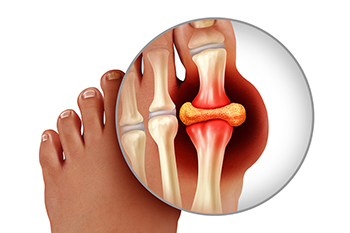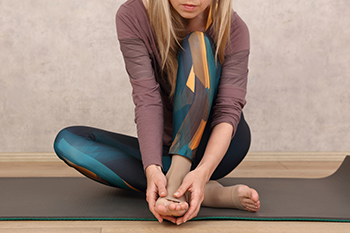April 2022
Gout Is Arthritis

A common form of inflammatory arthritis is known as gout. It can be extremely uncomfortable and can cause severe pain. It frequently affects the joints in the big toe, and may make walking difficult. Gout develops as a result of a buildup of uric acid, which may come from specific foods, including red meat and shellfish, as well as drinking alcoholic beverages. In addition to pain in the big toe, common symptoms can consist of swelling, redness, and lumps that are painless under the skin. Prevention methods include losing excess weight, avoiding foods that can trigger gout attacks, and eating foods high in vitamin C. Additionally, implementing a gentle exercise routine may help to manage gout. If you have this type of pain in your big toe, please speak with a podiatrist who can discuss prevention techniques and offer treatment solutions.
Gout is a foot condition that requires certain treatment and care. If you are seeking treatment, contact Dr. Kirk Sherris from Liberty Bay Foot & Ankle. Our doctor will treat your foot and ankle needs.
What Is Gout?
Gout is a type of arthritis caused by a buildup of uric acid in the bloodstream. It often develops in the foot, especially the big toe area, although it can manifest in other parts of the body as well. Gout can make walking and standing very painful and is especially common in diabetics and the obese.
People typically get gout because of a poor diet. Genetic predisposition is also a factor. The children of parents who have had gout frequently have a chance of developing it themselves.
Gout can easily be identified by redness and inflammation of the big toe and the surrounding areas of the foot. Other symptoms include extreme fatigue, joint pain, and running high fevers. Sometimes corticosteroid drugs can be prescribed to treat gout, but the best way to combat this disease is to get more exercise and eat a better diet.
If you have any questions please feel free to contact our office located in Poulsbo, WA . We offer the newest diagnostic and treatment technologies for all your foot and ankle needs.
The Pandemic and Running Injuries
 The pandemic prevented many people from engaging in workouts in the gym. Research has shown it may help to begin running slowly on the treadmill before venturing outside on pavement or trails. This may help to prevent running injuries and may be a result of the body warming up to run again. It is suggested that when people resume running outside, the speed and mileage are gradually increased. Covid 19 isolation may have changed people’s running habits, and this may have happened from anxiety, remote work, and schooling. They may have had less time to run than they previously had and may compensate for that by running harder and longer. Wearing shoes that fit correctly and being aware of your running regime is instrumental in preventing running injuries. If you would like information about how running injuries can affect the feet, please consult with a podiatrist, who can recommend additional methods on how to prevent them.
The pandemic prevented many people from engaging in workouts in the gym. Research has shown it may help to begin running slowly on the treadmill before venturing outside on pavement or trails. This may help to prevent running injuries and may be a result of the body warming up to run again. It is suggested that when people resume running outside, the speed and mileage are gradually increased. Covid 19 isolation may have changed people’s running habits, and this may have happened from anxiety, remote work, and schooling. They may have had less time to run than they previously had and may compensate for that by running harder and longer. Wearing shoes that fit correctly and being aware of your running regime is instrumental in preventing running injuries. If you would like information about how running injuries can affect the feet, please consult with a podiatrist, who can recommend additional methods on how to prevent them.
All runners should take extra precaution when trying to avoid injury. If you have any concerns about your feet, contact Dr. Kirk Sherris of Liberty Bay Foot & Ankle. Our doctor will treat your foot and ankle needs.
How to Prevent Running Injuries
There are a lot of mistakes a runner can make prior to a workout that can induce injury. A lot of athletes tend to overstretch before running, instead of saving those workouts for a post-run routine. Deep lunges and hand-to-toe hamstring pulls should be performed after a workout instead of during a warmup. Another common mistake is jumping into an intense routine before your body is physically prepared for it. You should try to ease your way into long-distance running instead of forcing yourself to rush into it.
More Tips for Preventing Injury
- Incorporate Strength Training into Workouts - This will help improve the body’s overall athleticism
- Improve and Maintain Your Flexibility – Stretching everyday will help improve overall performance
- “Warm Up” Before Running and “Cool Down” Afterward – A warm up of 5-10 minutes helps get rid of lactic acid in the muscles and prevents delayed muscle soreness
- Cross-Training is Crucial
- Wear Proper Running Shoes
- Have a Formal Gait Analysis – Poor biomechanics can easily cause injury
If you have any questions, please feel free to contact our office located in Poulsbo, WA . We offer the newest diagnostic and treatment technologies for all your foot care needs.
It's Time for Beautiful Feet
Diabetes May Increase Your Risk of PAD
Diabetes may increase your risk of peripheral arterial disease (PAD), which is a narrowing of the arteries due to prolonged elevated blood glucose levels. PAD may lead to poor circulation. Symptoms of PAD in your lower extremities may include brittle toenails, cold or numb feet, a loss of hair on the feet or legs, a bluish tinge to the skin on the legs, cracked or dry skin on the feet, leg pain that subsides with rest (intermittent claudication), and more. If you are experiencing any of these symptoms, it is suggested that you get examined and evaluated by a podiatrist. A podiatrist will be able to test the blood flow in your feet by performing a non-invasive and pain-free ankle-brachial pressure index test—also known as an ABPI, or ABI, test. If your podiatrist makes a diagnosis of PAD, they can manage your symptoms and help prevent more serious complications from developing with a variety of therapies.
Poor circulation is a serious condition and needs immediate medical attention. If you have any concerns with poor circulation in your feet contact Dr. Kirk Sherris of Liberty Bay Foot & Ankle. Our doctor will treat your foot and ankle needs.
Poor Circulation in the Feet
Poor blood circulation in the feet and legs is can be caused by peripheral artery disease (PAD), which is the result of a buildup of plaque in the arteries.
Plaque buildup or atherosclerosis results from excess calcium and cholesterol in the bloodstream. This can restrict the amount of blood which can flow through the arteries. Poor blood circulation in the feet and legs are sometimes caused by inflammation in the blood vessels, known as vasculitis.
Causes
Lack of oxygen and oxygen from poor blood circulation restricts muscle growth and development. It can also cause:
- Muscle pain, stiffness, or weakness
- Numbness or cramping in the legs
- Skin discoloration
- Slower nail & hair growth
- Erectile dysfunction
Those who have diabetes or smoke are at greatest risk for poor circulation, as are those who are over 50. If you have poor circulation in the feet and legs it may be caused by PAD and is important to make changes to your lifestyle in order to reduce risk of getting a heart attack or stroke. Exercise and maintaining a healthy lifestyle will dramatically improve conditions.
As always, see a podiatrist as he or she will assist in finding a regimen that suits you. A podiatrist can also prescribe you any needed medication.
If you have any questions please feel free to contact our office located in Poulsbo, WA . We offer the newest diagnostic and treatment technologies for all your foot and ankle needs.
Types of Corns
 Repeated friction on the foot can result in developing corns. They are hardened areas of skin, and some can cause pain and discomfort. There are three kinds of corns, consisting of hard, soft, and seed. Corns that form on the sole of the foot are referred to as seed corns, and they are generally found in groups. Hard corns can form on top of the toes, and may come from wearing shoes that do not fit correctly. Soft corns are found between the toes, and are typically moist. Relief for most corns can be found when the correct shoes are worn, and wearing specific socks may help to reduce some of the friction. Some patients can experience pain with corns, and it may interfere with completing daily activities. If you have developed any type of corn on your foot, it is suggested that you confer with a podiatrist who can provide the best options for you.
Repeated friction on the foot can result in developing corns. They are hardened areas of skin, and some can cause pain and discomfort. There are three kinds of corns, consisting of hard, soft, and seed. Corns that form on the sole of the foot are referred to as seed corns, and they are generally found in groups. Hard corns can form on top of the toes, and may come from wearing shoes that do not fit correctly. Soft corns are found between the toes, and are typically moist. Relief for most corns can be found when the correct shoes are worn, and wearing specific socks may help to reduce some of the friction. Some patients can experience pain with corns, and it may interfere with completing daily activities. If you have developed any type of corn on your foot, it is suggested that you confer with a podiatrist who can provide the best options for you.
If you have any concerns regarding your feet and ankles, contact Dr. Kirk Sherris of Liberty Bay Foot & Ankle. Our doctor will treat your foot and ankle needs.
Corns: What Are They? and How Do You Get Rid of Them?
Corns can be described as areas of the skin that have thickened to the point of becoming painful or irritating. They are often layers and layers of the skin that have become dry and rough, and are normally smaller than calluses.
Ways to Prevent Corns
There are many ways to get rid of painful corns such as wearing:
- Well-fitting socks
- Comfortable shoes that are not tight around your foot
- Shoes that offer support
Treating Corns
Treatment of corns involves removing the dead skin that has built up in the specific area of the foot. Consult with Our doctor to determine the best treatment option for your case of corns.
If you have any questions please feel free to contact our office located in Poulsbo, WA . We offer the newest diagnostic and treatment technologies for all your foot and ankle needs.








